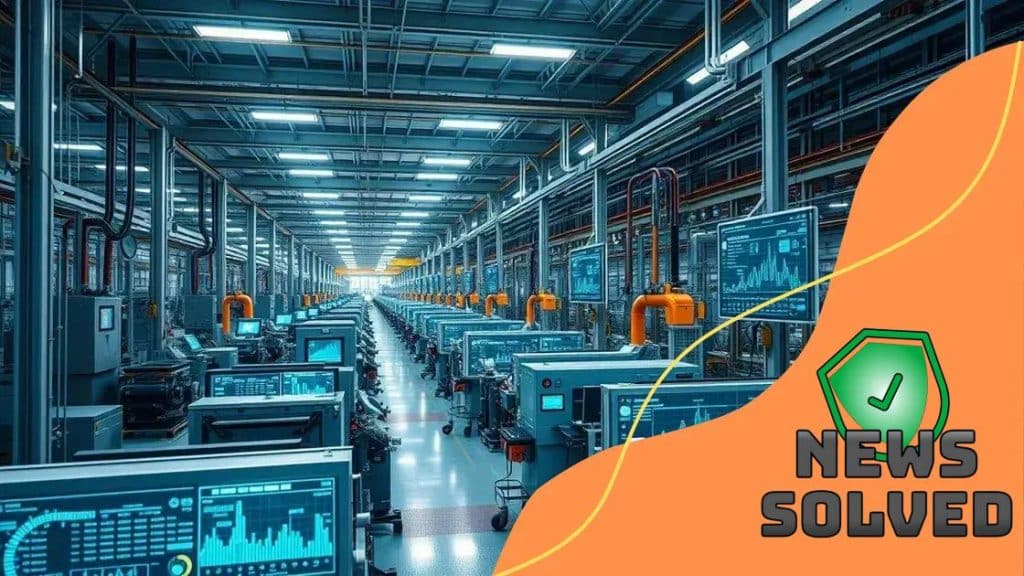How AI is shaping predictive maintenance in manufacturing

Advertisements
How AI is shaping predictive maintenance in manufacturing involves leveraging technologies like IoT and machine learning to anticipate equipment failures, reducing downtime and improving operational efficiency.
How AI is shaping predictive maintenance in manufacturing is transforming the industry by minimizing downtimes and boosting efficiency. Have you ever wondered how new technologies can predict failures before they happen?
Advertisements
Understanding predictive maintenance
Understanding predictive maintenance is crucial for manufacturers seeking to enhance their operational efficiency. This proactive approach leverages data to foresee equipment failures before they occur, allowing companies to optimize their maintenance schedules and reduce unplanned downtimes.
Predictive maintenance uses various technologies and data analysis methods to achieve its goals. Some key components include:
Key Techniques
A few of the main techniques include:
Advertisements
- Vibration Analysis: Monitoring equipment vibrations can reveal signs of wear or failure.
- Thermal Imaging: Detecting heat anomalies helps in identifying overheating components.
- Oil Analysis: Examining lubricants provides insights into machinery health.
These methods form part of a comprehensive strategy for predictive maintenance. By analyzing data collected from the equipment, manufacturers can gain valuable insights into when maintenance should occur. This data-driven approach not only enhances reliability but also extends the lifespan of machinery.
Moreover, implementing predictive maintenance involves integrating Internet of Things (IoT) devices to collect real-time data. These devices can monitor performance metrics continuously, sending alerts whenever something seems off. As a result, maintenance teams can act swiftly, preventing small issues from escalating into costly breakdowns.
Benefits of Predictive Maintenance
The advantages of adopting predictive maintenance are manifold:
- Cost Savings: By fixing issues before they lead to failures, companies can save significantly on repair costs.
- Increased Efficiency: Equipment runs smoothly when maintenance is timely, reducing downtime.
- Improved Safety: Regular monitoring helps ensure machinery operates within safe parameters.
Overall, understanding predictive maintenance is essential in today’s manufacturing landscape. It allows businesses to be more proactive, less reactive. By adopting this approach, companies are not just fixing problems; they are predicting and preventing them, leading to a more efficient and safe working environment.
Benefits of AI in manufacturing
Benefits of AI in manufacturing are numerous and transformative. As industries evolve, implementing artificial intelligence allows companies to enhance their operations significantly. With AI, manufacturers can streamline processes, reduce costs, and improve product quality.
The integration of AI leads to increased productivity across various stages of production. With the help of data analytics, businesses can identify bottlenecks and inefficiencies. This data-driven approach equips teams to optimize workflows, making them more efficient and responsive to changing demands.
Key Advantages of AI
Some notable advantages include:
- Enhanced Quality Control: AI systems can analyze products for defects at a much faster rate than humans, ensuring higher standards.
- Predictive Analytics: With advanced algorithms, AI can predict future conditions, allowing for timely decisions and actions.
- Reduced Operational Costs: Automation driven by AI minimizes labor costs and improves resource allocation.
- Better Supply Chain Management: AI assists in managing logistics and inventory more effectively, reducing waste.
The ability to analyze large volumes of data in real time offers manufacturers insights that were previously unattainable. Such insights enable proactive decision-making, preventing issues before they escalate. For instance, AI can monitor machinery and predict failures, leading to timely maintenance. This proactive approach not only saves money but also enhances safety in manufacturing environments.
Furthermore, AI supports innovation in product design and development. By simulating various design parameters, AI helps manufacturers create products that meet customer needs more precisely. The iterative design process becomes faster and more efficient, leading to quicker market delivery.
Overall Impact
The overall impact of AI in manufacturing is profound. As companies adopt AI tools, they not only stay competitive but also prepare for future challenges. This technological shift empowers organizations to innovate continuously and adapt to market demands more effectively.
Key technologies driving predictive maintenance

Key technologies driving predictive maintenance play a vital role in the modern manufacturing landscape. These innovations enable businesses to foresee equipment issues before they occur, ultimately leading to less downtime and reduced costs. Various technologies come together to create a robust predictive maintenance framework.
One of the primary technologies used is the Internet of Things (IoT). IoT devices collect real-time data from machines, which can be analyzed to determine operational status. This data is crucial in identifying patterns and predicting potential failures. When connected sensors monitor various machine parameters, manufacturers can gain a clearer picture of their equipment’s health.
Advanced Analytics
Another essential technology is advanced analytics. By employing machine learning algorithms, businesses can analyze historical data to find correlations and trends. This analysis helps in making informed decisions about maintenance schedules. The predictive models created can effectively forecast when a machine is likely to need service.
- Data Visualization: Tools that present data in a clear and engaging manner help teams quickly grasp machine performance.
- Predictive Models: These models are built using statistical methods to analyze large sets of data and generate forecasts.
- Risk Assessment: Advanced analytics aids in evaluating which pieces of equipment need urgent attention based on their performance data.
Additionally, cloud computing provides a scalable infrastructure for managing large amounts of data. Storing and processing data in the cloud allows manufacturers to access information from anywhere, enabling collaboration among teams. This flexibility is essential for companies looking to stay competitive.
Another critical component is Artificial Intelligence (AI). Machine learning and AI algorithms can help interpret the data gathered by IoT devices, automating the process of identifying when maintenance is necessary. AI not only improves accuracy but also speeds up the decision-making process. Through continuous learning, these systems become smarter over time, adapting to enhance predictive capabilities.
Conclusion
Overall, key technologies such as IoT, advanced analytics, cloud computing, and AI are at the forefront of predictive maintenance strategies. They work together to create a system that increases reliability and efficiency in manufacturing environments.
Real-world examples of AI implementation
Real-world examples of AI implementation in manufacturing highlight how companies use technology to enhance processes and improve efficiency. Many industries have successfully integrated AI to solve complex problems and optimize operations.
One prominent example is the automotive industry, where manufacturers utilize AI for quality assurance. Companies like Toyota have implemented AI-powered systems that monitor production lines. These systems can detect defects in real time, ensuring that only high-quality vehicles reach consumers. By automating inspections, these manufacturers save time and reduce human error.
Predictive Maintenance in Action
Another great example is in predictive maintenance. General Electric (GE) uses AI algorithms to analyze data from various sensors in their jet engines. This analysis enables them to predict when an engine component might fail. As a result, they can perform maintenance before an actual failure occurs, leading to safer flights and reduced maintenance costs.
- Increased Equipment Uptime: AI helps companies maintain continuous production by preventing unexpected breakdowns.
- Optimized Resource Allocation: By predicting failures, businesses can allocate maintenance resources more effectively.
- Enhanced Safety Measures: Anticipating issues allows for safer working environments.
Another industry making strides with AI is electronics. Companies like Samsung employ AI for supply chain management. By analyzing market trends and customer preferences, Samsung can optimize its inventory. This ensures that the right products are in stock at the right time, which enhances customer satisfaction.
AI and Energy Efficiency
Lastly, companies in the energy sector have adopted AI to maximize efficiency. Siemens is using AI to manage energy consumption in smart factories. Their systems analyze energy use patterns and suggest ways to reduce waste. This not only cuts costs but also supports sustainability efforts.
These real-world applications demonstrate how AI is reshaping manufacturing. The technology not only improves operational efficiency but also fosters innovation. As more industries adopt AI, we can expect to see even greater advancements in productivity and quality.
Future trends in predictive maintenance
Future trends in predictive maintenance show exciting advancements as technology continues to evolve. As more businesses adopt artificial intelligence, the landscape of maintenance strategies will significantly change. Companies are beginning to understand that predictive maintenance is not just a trend; it is becoming essential for competitiveness.
One of the key trends is the use of machine learning algorithms to improve predictive accuracy. These algorithms analyze vast amounts of data to detect patterns that humans might miss. As they learn from new data, their predictions will become even more precise. This ability to adapt will enable manufacturers to respond swiftly to potential issues.
Integration with IoT
Another significant trend is the integration of Internet of Things (IoT) devices. These devices continuously collect data from equipment, offering real-time insights into machine performance. The data gathered can be crucial for understanding equipment health and identifying early signs of wear and tear. This trend will lead to even more effective predictive maintenance systems that operate based on actual conditions rather than just scheduled maintenance.
- Cloud Computing: Utilizing cloud solutions allows companies to store and analyze data without significant investments in on-site infrastructure.
- Advanced Data Analytics: Companies will increasingly deploy advanced analytics tools to turn raw data into actionable insights.
- Enhanced Visualization Tools: New tools will help teams visualize machine performance, making it easier to understand and act upon data.
Additionally, as technology progresses, the concept of digital twins will likely gain traction. A digital twin is a virtual model of a physical object that uses real-time data to simulate behavior. By creating digital twins of machines, manufacturers can test maintenance strategies and predict failures without risking actual equipment. This allows for a trial-and-error approach in a safe environment.
Focus on Sustainability
Moreover, the focus on sustainability will influence predictive maintenance practices. Companies will seek to reduce waste and increase energy efficiency through smarter maintenance solutions. Predictive maintenance will help by ensuring that machines operate optimally, which in turn minimizes energy consumption and material waste.
As predictive maintenance evolves, it will not only improve operational efficiency but also lead to safer workplaces. By anticipating equipment failures, businesses can take preventive measures, ensuring a safer working environment for their employees. The future of predictive maintenance is bright, and companies that integrate these trends will be well-positioned for success.
FAQ – Frequently Asked Questions about Predictive Maintenance
What is predictive maintenance?
Predictive maintenance is a proactive approach that anticipates equipment failures using data analysis and technology, allowing for timely maintenance before issues arise.
How does IoT contribute to predictive maintenance?
IoT devices collect real-time data from machinery, enabling manufacturers to monitor performance and identify potential failures quickly.
What role does AI play in predictive maintenance?
AI analyzes large datasets to detect patterns and predict failures, improving the accuracy of maintenance schedules and enhancing equipment reliability.
What are the benefits of implementing predictive maintenance?
Benefits include reduced downtime, increased operational efficiency, lower maintenance costs, and improved safety in the workplace.





